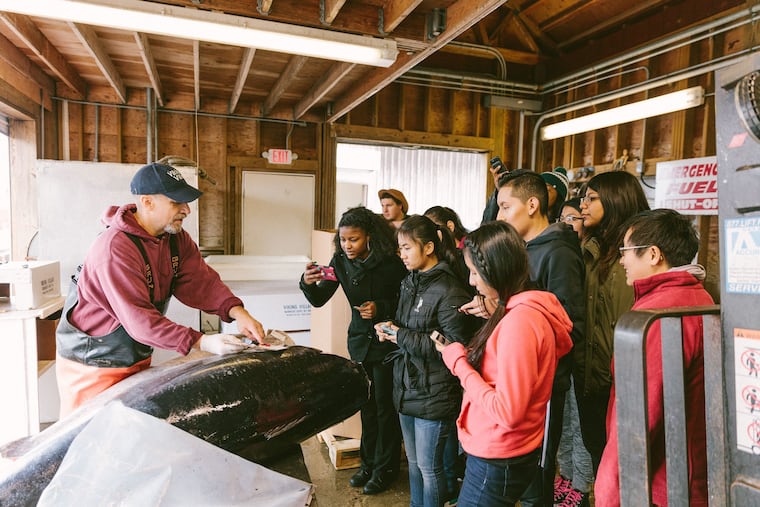Fishadelphia and Philly high schoolers are making local seafood more accessible
Fishadelphia subscribers get everything from skate to squid, bluefish to dogfish, black sea bass to porgy. They're even exploring local lobster suppliers. But one thing is guaranteed: The fish will be super-fresh.

For some home cooks, fish can be intimidating, expensive, easy to overcook, and polarizing. That might explain why the average American consumed just 16 pounds of seafood in 2017, compared to 92 pounds of chicken and 57 pounds of beef.
But former South Philly science teacher and Princeton post-doc fellow Talia Young sees fish differently. While she has devoted much of her academic career to studying fish, fisheries, and food supply chains, she’s also a lifelong consumer of seafood; as a Chinese American kid growing up in New York City, she routinely ate jellyfish, whole fish, shrimp, and crab.
“In my experience in working-class communities,” she says, “it’s a thing that people eat even if they’re really cash-strapped.”
So Young was surprised at a 2016 fisheries conference when a fisherman stood up and said to the crowd, “‘Americans only know how to eat cod and salmon fillets, and we need to teach them how to eat other kinds of fish.’”
“And I was like, ‘What Americans are you talking about?’” she says.
That’s part of the origin story of Fishadelphia, the community-supported fishery Young founded in 2018 to connect New Jersey fisheries with Philly customers. Sign up for the CSF’s orange club and you’ll get a pound’s worth of freshly caught fish fillets or shellfish — plus a recipe and cooking suggestions — every other week. Or be bold and opt for the blue club; you’ll receive 1 to 3 pounds of whole fish to break down yourself at home. (Fishadelphia’s spring season is prorated and runs through mid-May.)
What fish can you expect? Anything from skate to squid, bluefish to dogfish, black sea bass to porgy. It could be oysters or clams, monkfish or mackerel. Young is even lining up a local lobster supplier.
One thing is unquestionable, though. “Our seafood is so fresh,” Young says. “We’ve had scallops that were landed the morning we got them.” When customers text to ask what’s coming, she tells them she doesn’t know yet: “It’s still swimming.”
Young places the group’s order — usually between 200 and 400 pounds — on Mondays with one of the Jersey fishermen and farmers they collaborate with, including Viking Village in Barnegat Light, Cape May’s Sweet Amalia Oyster Farm, Point Pleasant Fisherman’s Dock Cooperative, and Maxwell Seafood in Port Republic. From there, Fishadelphia’s clam and fish wrangler, George Mathis, picks it up from the docks and takes the catch to Randall’s Seafood in Pleasantville, where about two-thirds of the order is broken down into fillets.
On Wednesdays or Thursdays, the catch is packed into coolers and Mathis transports it to two Philly high schools for Thursday and Friday pickup and distribution.
“High school??” you might ask.
Fishadelphia is actually run by students at Mastery Charter School Thomas Campus and its North Philadelphia counterpart, Simon Gratz High School. With assistance from Young and a few other team members, the kids package the fish, balance the books, on-board new customers, and manage the program’s social media and community outreach.
“It’s a business that these kids have a stake in,” Young says. They’re paid hourly and meet twice a week for a couple hours at a time. (Grants from the USDA and the David H. Smith Conservation Fellowship help fund the program, which is applying for nonprofit status.)
The students — 10 participants at Thomas, and 13 or so at Gratz — also connect Fishadelphia to a broader, more diverse customer base. “The first year, we had the kids make flyers in four languages. We had a Burmese kid who was selling fish to the Burmese Christian community in South Philly that speaks Chin, this tiny minority language.
“This is not a community that either of us would ever have reached,” Young says, referring to herself and Fishadelphia youth development coordinator Tasha Palacio. “But it’s certainly not a community that the docks were ever going to reach.”
To foster its grassroots base, the program uses a two-tiered pricing structure: a regular rate and a community rate, offered to customers who send students to Thomas or Gratz, or who are eligible for SNAP assistance, or those who are referred by a community-rate customer. According to Young, the regular rate shakes out to be similar to that of the Whole Foods seafood counter (about $22 per delivery for fillets), while the community rate is more in line with Chinatown prices (around $12 per delivery for fillets).
Another advantage of the program’s school ties is that they provide a familiar place for community customers to pick up their fish. “To me, Fishadelphia doesn’t feel like going to the co-op,” Palacio says. “They’re still in their own community.”
And to make things convenient for customers who live farther afield, Fishadelphia has porch pickups — hosted by subscribers — in Bella Vista, East and West Passyunk, West Philly, Fishtown, the Northeast, and more. (Porch pickup hosts are also eligible for discounted rates.) They added 12 locations this season to accommodate their membership, currently around 150 — up 50% from last season.
To keep apace, “We need to up our kids,” Young says. “We’re recruiting. … We would never be able to do this without the students.”